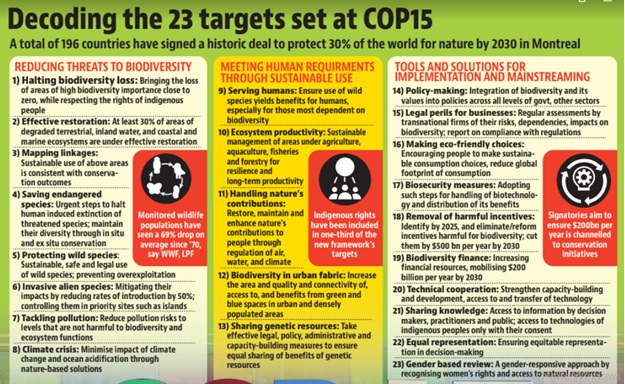Kunming-Montreal Global Biodiversity Framework
Why in the News?
Recently, at the 15th Conference of Parties (COP15) to the UN Convention on Biological Diversity “Kunming-Montreal Global Biodiversity Framework” (GBF) was adopted.
- By 2030, the GBF has 23 targets and 4 goals that must be met.
- In Montreal, Canada, the U.N. biodiversity conference came to an end.
- Over 100 nations adopted the Kunming Declaration during the first session of COP 15 in Kunming, China, which strengthened the resolve to confront the biodiversity crisis.
What are the Key Targets of the GBF?
- 30×30 Deal:
- Restore 30% degraded ecosystems globally (on land and sea) by 2030
- Conserve and manage 30% areas (terrestrial, inland water, and coastal and marine) by 2030
- Stop known species from going extinct, and by 2050, tenfold the risk and rate of extinction for all species (including unknown)
- By 2030, cut the danger from pesticides by at least 50%.
- By 2030, cut the amount of nutrients lost to the environment by at least 50%.
- By 2030, reduce pollution risks and adverse effects from all sources to levels safe for biodiversity and ecosystem functions.
- Reduce the global footprint of consumption by 2030, in part by cutting back on waste production, overconsumption, and food waste.
- Manage agricultural, aquaculture, fisheries, and forestry regions sustainably, and significantly expand agroecology and other activities that promote biodiversity.
- combat climate change with natural remedies
- Reduce the rate of introduction and establishment of invasive alien species by at least 50% by 2030
- Secure the safe, legal and sustainable use and trade of wild species by 2030
- Green up urban spaces
What are the Other Major Outcomes of COP15?
- Money for Nature:
- The signatories want to make sure that both public and private funding, amounting to USD200 billion annually, is directed toward conservation efforts.
- By 2025 and 2030, wealthier nations should each make annual contributions of at least $20 billion and $30 billion, respectively.
- Big Companies Report Impacts on Biodiversity:
- Companies should analyse and report how their operations affect and are affected by biodiversity issues.
- The parties agreed to large companies and financial institutions being subject to “requirements” to make disclosures regarding their operations, supply chains and portfolios.
- Harmful Subsidies:
- By 2025, the participating nations agreed to identify the subsidies that harm biodiversity and either remove, phase out, or reform them.
- By 2030, they pledged to reduce those incentives by at least USD 500 billion annually and boost those that encourage conservation.
- Monitoring and reporting progress:
- To avoid this agreement having the same outcome as identical targets that were agreed upon in Aichi, Japan, in 2010, and never realised, all agreed-upon aims will be supported by procedures to track progress in the future.
- In accordance with a similar framework used for greenhouse gas emissions under U.N.-led efforts to slow climate change, national action plans will be established and assessed. The absence of a timeframe for nations to submit these plans has drawn criticism from certain commentators.
How India Presented its Demands at the Conference?
- India emphasised the urgent need to establish a brand-new, special fund to assist poor nations in effectively putting into place a post-2020 global framework to stop and reverse biodiversity loss.
- The only source of money for biodiversity conservation is still the Global Environment Facility, which supports numerous accords like the UNFCCC and the UN Convention to Combat Desertification.
- India added that as climate change also affects nature, biodiversity preservation must also be based on “Common but Differentiated Responsibilities and Respective Capabilities” (CBDR).
- India claims that because poor nations are primarily responsible for carrying out the goals for biodiversity preservation, they need enough financing and technology transfer.
What is the Convention on Biological Diversity (CBD)?
- 196 countries have accepted the CBD, a legally binding agreement to conserve biodiversity, which has been in effect since 1993.
- It lays out rules for nations to safeguard sustainable use, encourage just and equitable benefit sharing, and save biodiversity.
- In line with the 2015 Paris Agreement on climate change, it seeks to achieve a historic agreement to stop and reverse the loss of biodiversity.
- Montreal, Canada serves as the home of the CBD Secretariat.
- The Conference of Parties refers to the periodical meetings of the Parties (Countries) to the CBD (COP).
- In 2000, a supplementary agreement to the Convention known as the Cartagena Protocol on Biosafety was adopted. It came into force on 11th September 2003.
- The Protocol seeks to protect biological diversity from the potential risks posed by living modified organisms resulting from modern biotechnology.
- At the COP10 conference in Nagoya, Japan, the Nagoya Protocol on Access to Genetic Resources and the Fair and Equitable Sharing of Benefits arising from their Utilization (ABS) was approved. It became effective on October 12, 2014.
- It applies to traditional knowledge (TK) associated with genetic resources covered by the CBD and the benefits resulting from its usage as well as to genetic resources covered by the CBD and the benefits resulting from their use.
- The COP-10 also approved a ten-year action plan for all nations to follow in order to preserve biodiversity. The Aichi Targets for biodiversity are a collection of 20 challenging but attainable goals that are officially known as the “Strategic Plan for Biodiversity 2011-2020.”
UPSC Civil Services Examination, Previous Year Questions (PYQs)
- “Momentum for Change: Climate Neutral Now” is an initiative launched by (2018)
(a) The Intergovernmental Panel on Climate Change
(b) The UNEP Secretariat
(c) The UNFCCC Secretariat
(d) The World Meteorological Organisation
Ans: (c)






